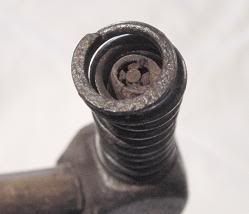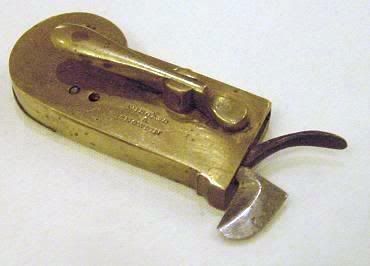946. Carrige maker's circular plough plane, made by Thomas Falconer, it's for cutting grooves in a curved surface. This tool won a Silver Medal from the Royal Society of Arts in 1846. I took these photos at an auction where the estimated value of this plane was $22,000-$26,000, I didn't stay to find out what it actually sold for.





947. Nutcracker, placed on the knee when seated, a nut is set in the hole and then struck with a hammer. In the winter, these were warmed by the fire before using.


948. Cobbler's or leather worker's hammer, used to make holes in leather. A bit inside the spring holds a nail by the head, the spring automatically extricates the nail after a hole has been made.


949. This is a doctor's spring loaded fleam, used for blood letting. The lever on the side is pulled out and the piece on the right is pulled up to set it, the side lever is then pushed to release the spring and actuate the blade.

950. Mountain climber's boot attachment for icy terrain.

951. A3P star projector by Spitz Space Systems, used in a planetarium, more info on the individual parts can be seen here.

Update:
860. This device is a watchmaker's Geneva glass gauge.

According to the Source Book for Rule Collectors:
The sizes of watch glasses are expressed in either Geneva or Lunette measurement, two different standards developed in Switzerland. Geneva measurement is expressed in units and 16ths, where a unit is approximately equal to .0825 of an inch, thus a watchmaker would say that a Waterbury watch takes a 18 1/16 Geneva crystal.
The crystal being measured would be placed on the surface of the gauge, its lower edge resting against the step, and its diameter determined by what graduation line it touched at its upper edge.
Thanks to Virginia White, Mid-West Tool Club "What's It" Columnist, and Otto van Poelje for providing the answer to this one.
More photos of this gauge can be found on the original answer page.
Another Geneva glass gauge has been posted here on ebay, where it is theorized that the pin on the side measures the inside height of the dome of the glass.
Last week's set is seen below, click here to view the entire post:

More discussion and comments on these photos can be found at the newsgroup rec.puzzles.


0 Comments:
Post a Comment
<< Home